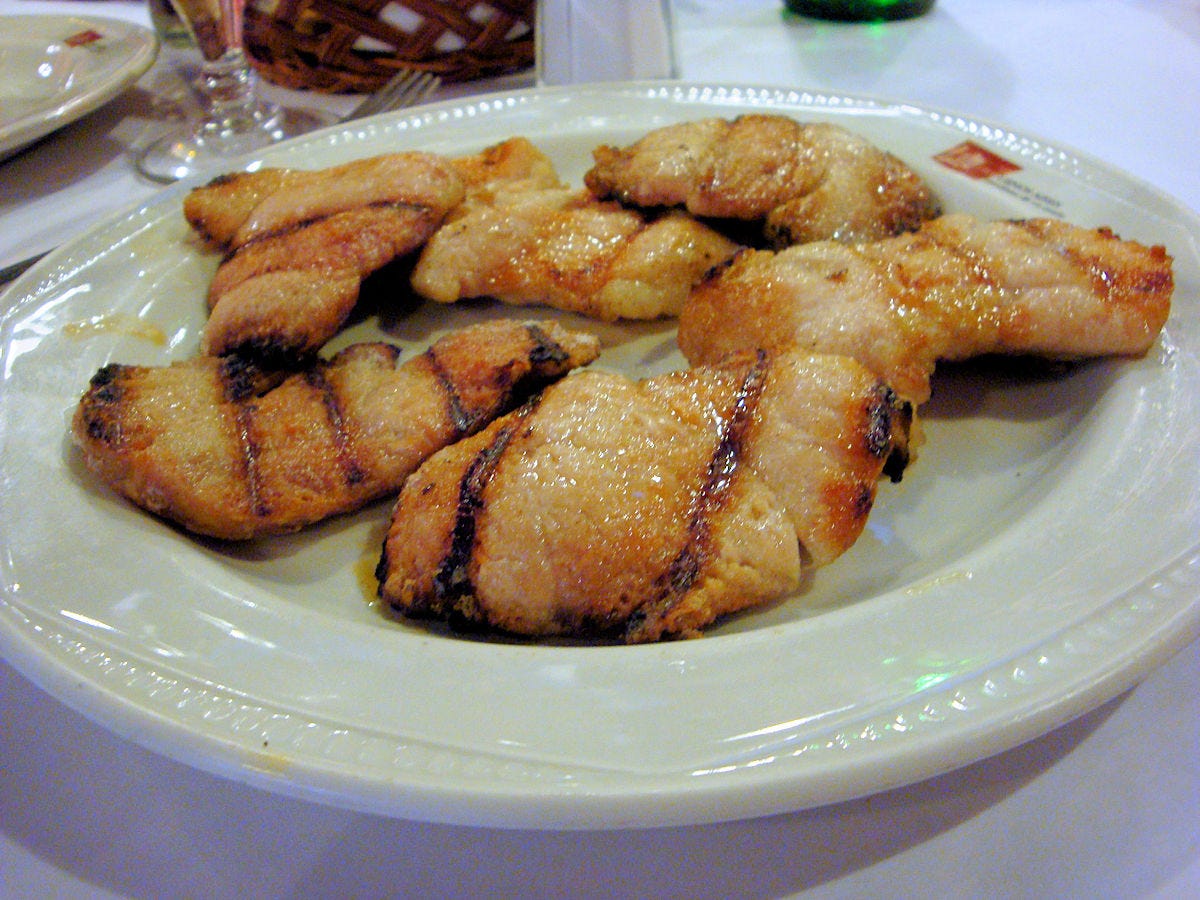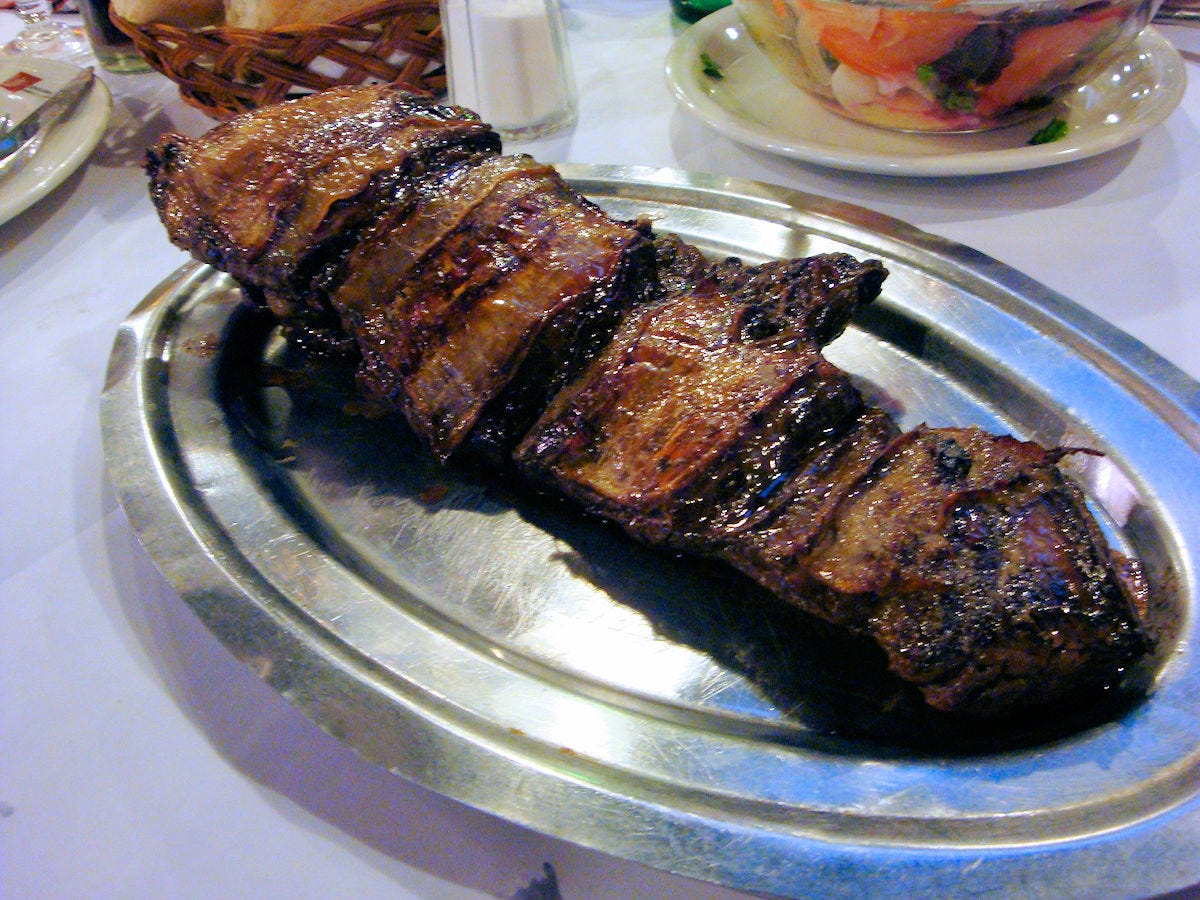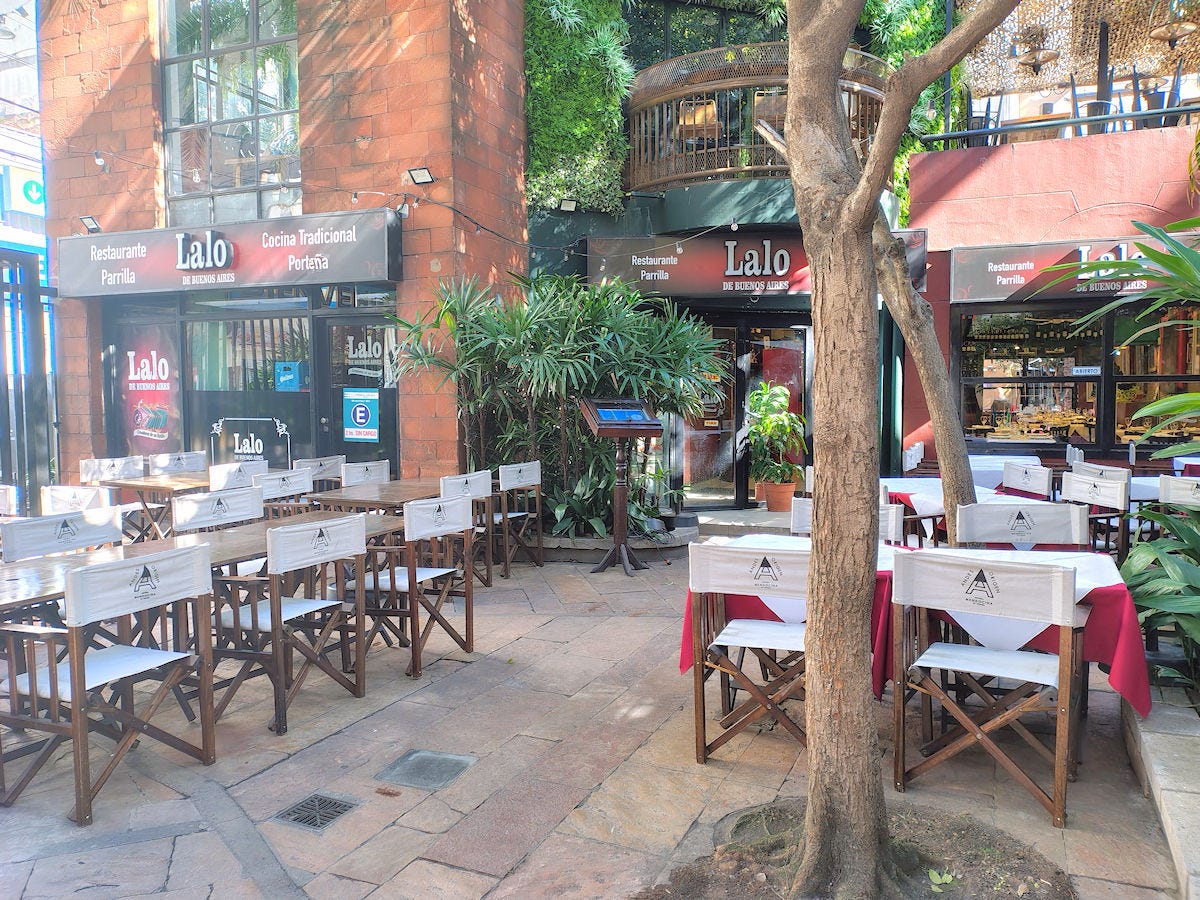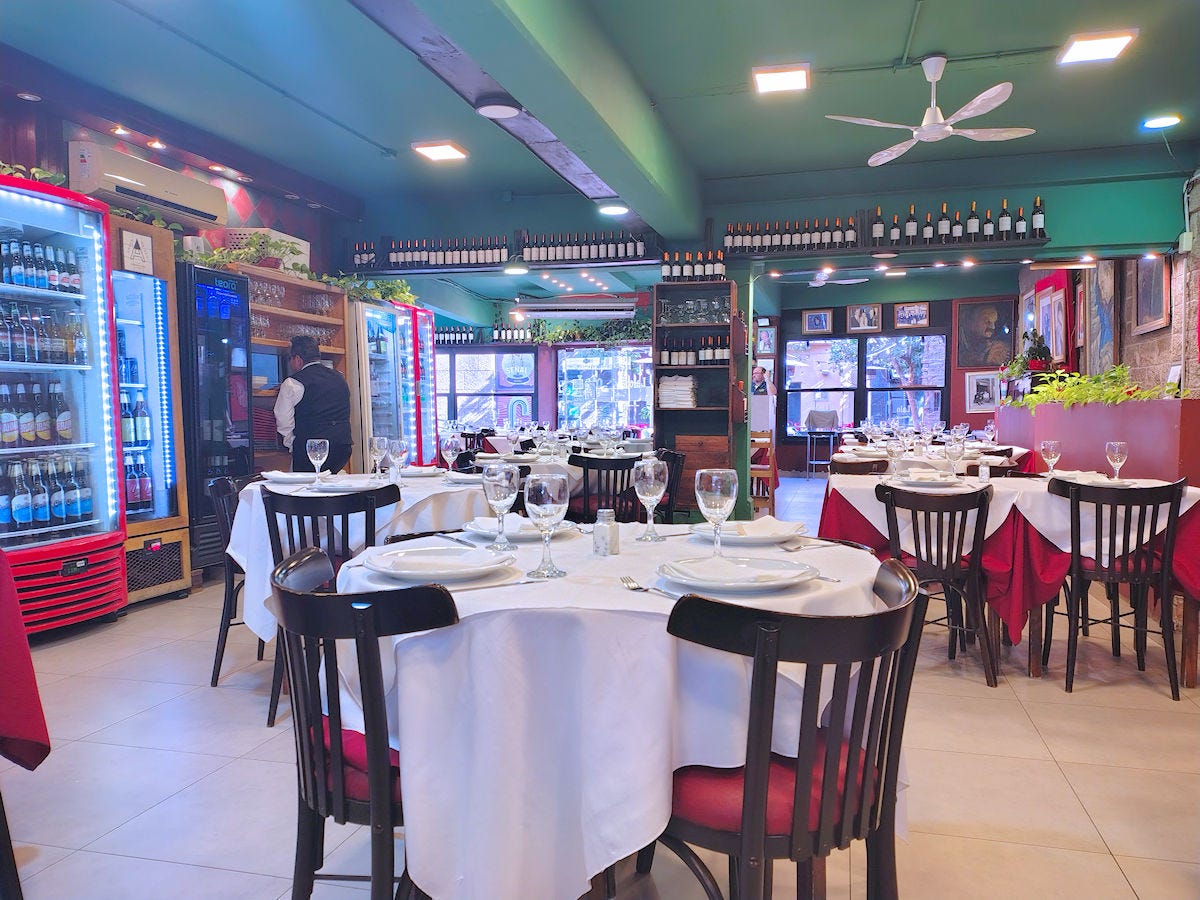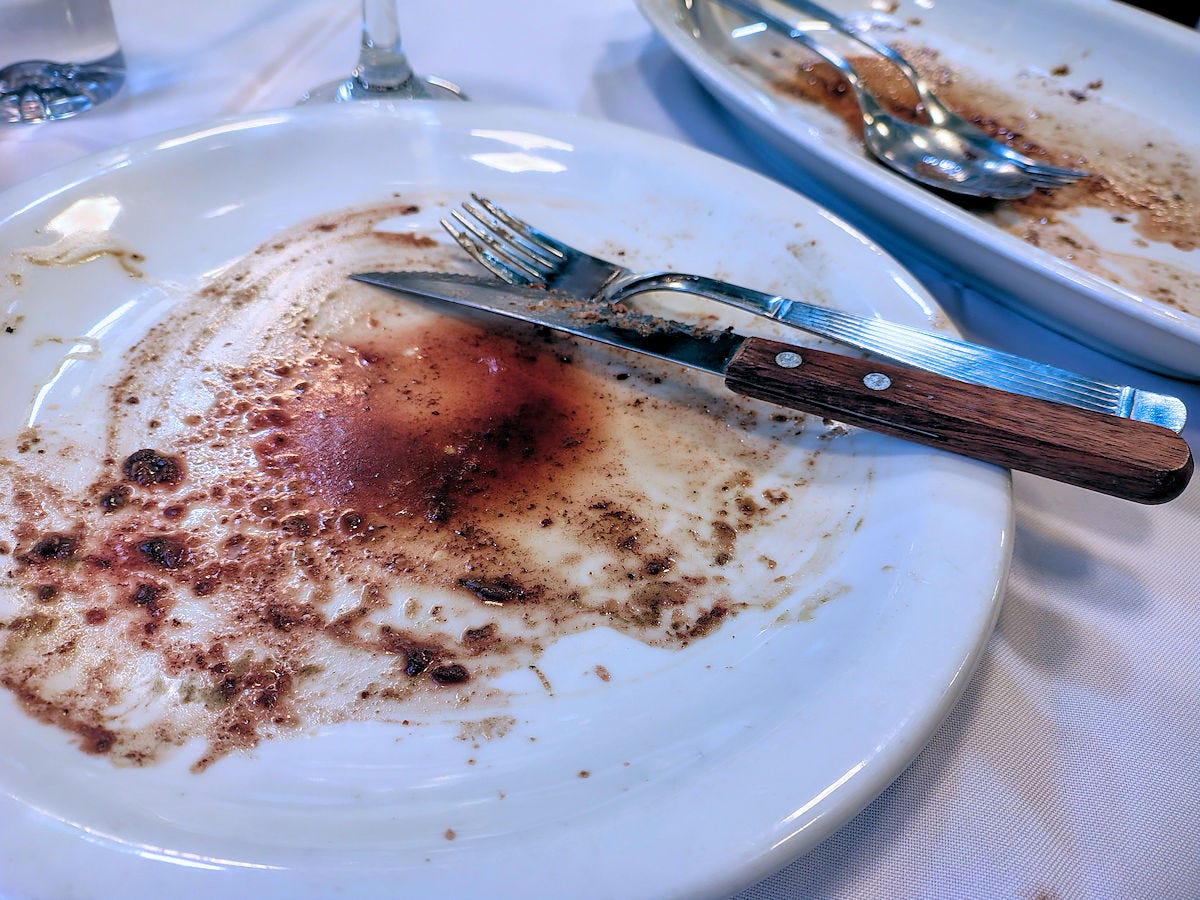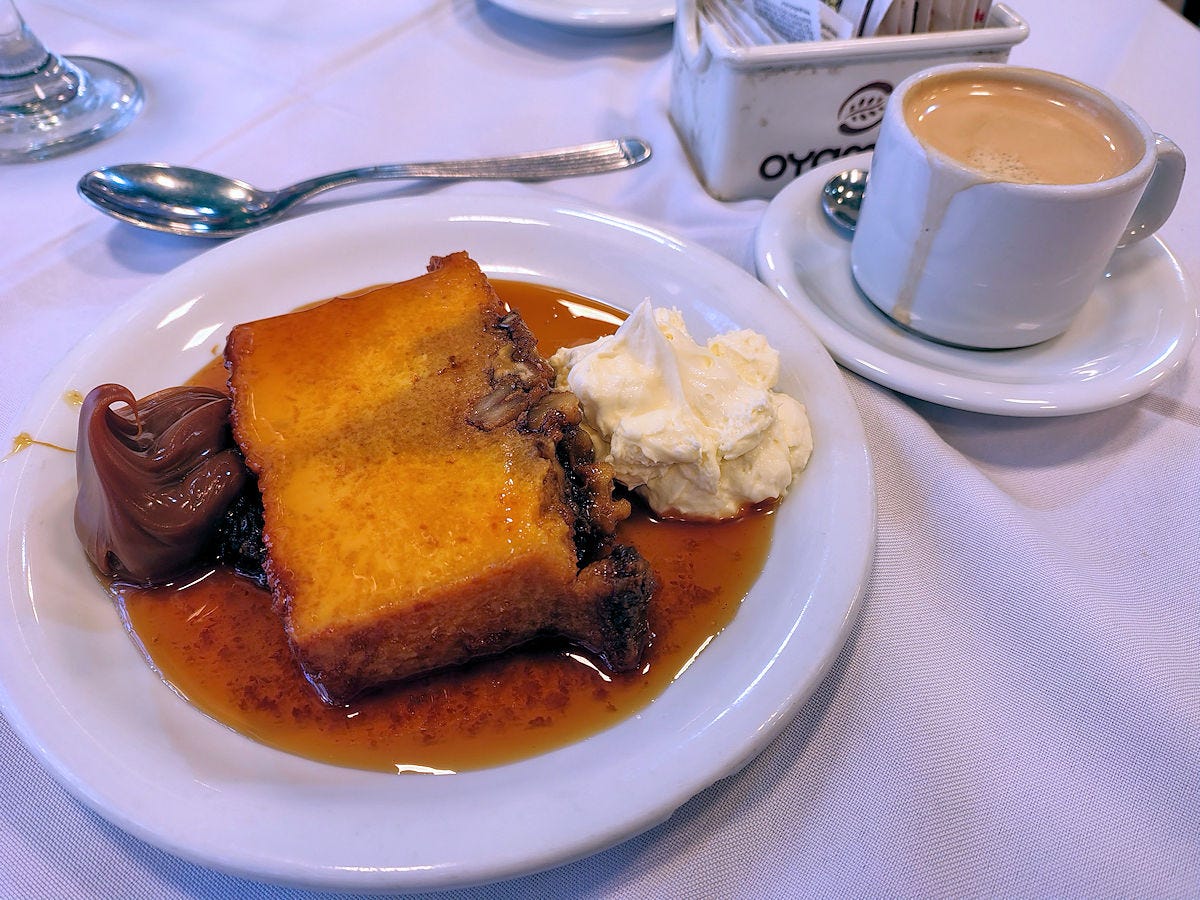Firing Up the Steaks of July, Part 2
In which I continue my historic reprise quest, re-reviewing favorites from the past.
We’re stepping back another five years from my first re-review in this historical reprise, to July 2010, fifteen years ago. At the time, Lalo was a popular steakhouse, or parrilla, located at Montevideo 353 in San Nicolás. It had opened in 2002, and at eight years old was going gangbusters. It was always full, and was a favorite spot to stop in for a steak, and great sweetbreads.
Back then my overall assessment was: “…huge, decorated in classic style with a mix of tango art and photos/portraits of one famous Argentine or another be they an actor, singer, or politician. Like many other traditional bodegones it needs some sprucing up, but overall is clean and well kept. The waiters have likely been there since the founding of the city and they’re friendly, efficient, and know their stuff. Wine list is nothing more than the usual big commercial suspects… Norton, Lopez, etc., though to their credit, Lalo stocks half bottles of quite a few of their wines, a nice plus if you’re dining alone.”
My thoughts on the food from my first visit: “these grilled sweetbreads have filled the void left behind when El Yugo closed last year. Not only are they perfectly cooked and seasoned, but it’s a generous portion that’s sufficient for two to share as an appetizer. They’ve certainly made it onto my “Best of” list.”
and
“Likewise, the entraña, or hangar steak, or skirt steak, there’s always some overlap. A hefty portion, the cooking spot-on, well-seasoned, everything you want from this cut. It is cooked al cuero, sort of – since the entraña doesn’t actually have direct skin contact, but it’s left on the membrane that attaches it where it is normally attached – some folks like that, some don’t, it’s the classic way to cook this cut and it’s not that hard to slice it off as you go. I don’t mind it, and Lalo’s steak here edges out El Trapiche’s, which had been my top place for the cut. As to side dishes – salads nice and fresh, and both dressed and tossed by the waiter at tableside, a really nice touch. Fries, just okay, a little oily – I’ve had better, I’ve had worse. They’re fine, but nothing special.”
In 2012, just two years later, things started to take a turn for the worse. Over the next year or so, the owner started to get behind on paying suppliers, and then, the employees. Bankruptcy was declared and the restaurant was shutdown. And here’s where things get interesting, in a way we don’t often see in other places, particularly the US. Argentine has a national law that allows for employees to take over a bankrupt company. It originally started with factories during the economic disaster period from 1999-2004. There’s a Canadian documentary film from 2004 called The Take, that profiles worker takeovers at two factories, resuming production, etc.
Now, I’m not going to do justice to the legal details, as I don’t fully understand them myself. But, from what I do understand, it seems that in the event of a bankruptcy, employees can takeover a company with a few caveats, and it’s all administered by some sort of governmental entity. They have to assume and settle the business’ debts, they have to be set up as a cooperative, with all initial participants being equal partners, and they have to show some level of business recovery and growth within a year in order to continue. While originally limited to certain types of production factories, over time it’s expanded and it’s not unusual to encounter various businesses, including quite a few restaurants, that are run by such worker cooperatives.
At some point, then, Lalo became Lalo de Buenos Aires, and moved across the street and down to the corner to Montevideo 306, becoming part of the Paseo La Plaza complex which includes a theater, shops, restaurants, and bars. It feels a bit more… cafeteria-ish. It’s still got some tango photos and paintings, but doesn’t have all the memorabilia of the past, and there are way too many brightly lit coolers facing into the dining room. Were it nicer weather, I’d have opted to sit outside on the patio - far nicer. This was a solo visit.
Not a promising start, with pretty mediocre, tasteless bread, though the eggplant escabeche is quite good. 1500 peso cubierto charge, a bit over a dollar.
I could have gone back to what I used to eat and gotten a half order of the grilled sweetbreads, but they’re just not a big part of my diet these days. Things change between your 40s and 60s, you know? I’ll split an order with someone else, but eating an entire plate, I feel it. So I stuck with what I’d ordered at the previous re-review - an empanada and a hanger steak.
The empanada does little to lift my spirits after musing over the bread. It came out within two minutes of ordering it, so it’s not being cooked to order (and I was the only person in the place when I arrived, though it got a little busier - there were maybe a dozen people by the time I left). It’s on the warm side of hot, so it’s probably just been sitting under a heat lamp. It’s fried, the dough is crumbly and tasteless. The filling is ground beef and little else other than a healthy dose of something sharply acidic, maybe vinegar. 2700 pesos, just over $2.
The half order of entraña, or hanger steak, looks a bit meager. Well not really, it’s plenty of food, easily over a half pound of steak, it just sort of feels like they’ve gone to rather cheap, thin, almost scrap pieces. It’s certainly not the thick, juicy steaks from days past. It’s also no longer cooked al cuero, on the membrane. It is, however, cooked a perfect medium rare, and really well seasoned with both salt and pepper.
I certainly don’t leave any of it behind. 27600 pesos for a half steak, just over $12.
Tangent here, on a pet peeve. What is this thing restaurants have about punishing single diners? It’s not unique to Argentina, though I find it often to be particularly egregious here. It’s like having a solo supplement on a cruise. They’re asking you to make up what they’re “losing” by there not being a second person at the table - i.e., there’s an empty seat. I can follow the logic if you’re a wildly popular restaurant that’s always full and people line up to get in, but this place was never more than about 10% full, and I’d bet rarely fills up. The “lost revenue” is purely theoretical with no basis in reality.
The price for a whole entraña is 39500, so the half price charge is 70%. That’s ridiculous. I don’t generally mind if someone charges a small amount extra, like 55-60%, albeit I still think it’s unfair to solo diners, but 70% is steep. I should also note that the menu doesn’t list half portions - all the steaks are for two to share, but it doesn’t say so, but almost all of them are available in half portion. That’s common in parrillas here, both not listing the option and not providing prices in advance for the half.
And I decide to finish the meal off with a slice of their budín de pan, or bread pudding. Argentine bread pudding, as I’ve mentioned in past posts, is quite different from American bread pudding. The bread, eggs, milk, etc., are blended together until they form a batter, which is then baked. This one is topped with candied walnuts and a single raisin, covered with a caramel-like syrup, and accompanied by whipped cream, dulce de leche, and a mediocre coffee. Very good version. Have I had better? Yes, but I’ve had many that were not remotely this good. 9900 pesos, about $7.50 for the dessert and 2700, or $2, for the coffee.
Overall - I don’t like the space as much as I liked the old one, but I’d probably be just fine with the outdoor patio area. Service is still great. The bread game needs to be improved. That empanada is just plain bad. But the steak and dessert were great. The steak isn’t as good as I remember at the old place, but other than the pricing, I’d still be happy eating it. The dessert, very happy.
A plus on bill - you can add the tip to a credit card payment. Something that’s becoming, slowly, more common in Argentina but still isn’t widespread. The stated reason is that owners don’t distribute the tips properly to the waitstaff, sometimes keeping part for themselves, or giving part to a manager who shouldn’t be part of the tip pool. But here, the waiters, and cooks, and everyone else, is a partner in the enterprise and shares in the whole profit, so it behooves them to simply add to the bottom line in any way they can.
Final assessment - it certainly wouldn’t be on my favorites list anymore, but it’s good.


